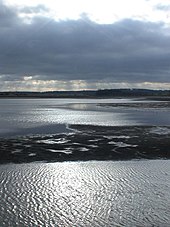Linderweiher
| Linderweiher - Etang de Lindre | ||
|---|---|---|

|
||
| Wetland at the Linderweiher near Tarquimpol | ||
| Geographical location | Moselle department , Grand Est region , France | |
| Tributaries | Ruisseau de Boule, Gros, Bacon Rau | |
| Drain | Seille | |
| Places on the shore | Tarquimpol | |
| Location close to the shore | Dieuze | |
| Data | ||
| Coordinates | 48 ° 47 '46 " N , 6 ° 45' 14" E | |
|
|
||
| surface | 6.2 km² | |
| volume | 13.2 million m³ | |
| Maximum depth | 6 m | |
The Linderweiher (French: Étang de Lindre ) is a more than 6 km² lake in the Moselle department of the Grand Est region , southeast of the city of Dieuze . It is embedded in the about a thousand hectares large Domaine de Lindre who by then- General was acquired by Lorraine 1976th The Domaine de Lindre in the Lorraine Regional Nature Park has twelve more lakes, some of which have been used extensively and some have been declared a bird sanctuary. Since 2003, an area with an area of over five thousand hectares has been designated as a Natura 2000 protected area. There is a great diversity of species in the landscape park; 248 species of birds, eleven amphibians and four reptile species have been identified in the fauna . It has also been possible to reintroduce the white stork (Ciconia ciconia) , which is very rare in France , among other things by installing nesting aids. The flora is represented by 19 protected plant species.
The Linderweiher itself has 6.2 km² of water surface, a volume of 13.2 million m³ and a maximum depth of six meters. The water catchment area is 103 km². The village of Tarquimpol is located on an elongated headland that extends far into the lake .
history
The Linderweiher at the place of the same name Linder (French: Lindre-Haute ) has existed in its current form since the 10th or 11th century. It was owned by the Dukes of Lorraine, the King of France, then the de Custine family, and became national property in 1790. In 1803 it was used to equip the Legion of Honor . On September 1, 1807 it was sold and was acquired by a cooperative of three financially strong people from the area: Georges-Timothée Masson from Nancy, Charles-Bernard de Maubon-Gand and David Braun from Fénétrange. Masson later also acquired the shares of his two co-owners: in 1817 the share of Braun and in 1828 the share of the Maubon-Grand heirs.
His son Antoine Achille Masson married Adélaïde Joséphine Bachasson de Montalivet, who was descended from a general of the Empire, and continued his father's acquisition policy. Around the pond he acquired goods in Assenoncourt, Azoudange, Lidrezing, Lindre-Basse, Loudrefing, Rorbach, Zommange, and finally in 1856 from Théodore Davillier also Guermange. At the time of their greatest expansion, the domaines de Lindre therefore comprised lands, forests and ponds in several communities, as well as the manor house that had once belonged to the Custines and six farms in the district of Guermange, namely the two farms belonging to the manor house, the Hisèlehof, the Stranhof, the Mühlhof and the so-called Freihaus. All were leased under the leadership of a general manager: Desfrères, under the Second Empire, then Bailly, at the end of the 19th century, barber, until the 1920s, and finally the Mélard family, Laurent until 1958, then his son Jean. Bornert took over this role after 1970 and the Mélard trial.
In 1908 the four heirs Masson de Montalivet merged to form the Société des Domaines de Lindre, Guermange et Dordhal . In the years 1950–1970 the statutes were changed to the other: in 1955 the forests of the domains were incorporated into the new forest enterprise of the manor and of Dordhal; In 1969, as part of the preparations for land consolidation, the land was transferred to the von Guermange agricultural company - four of the six farms in the domains were outsourced and the 280 hectare site was transferred to Mr de Pomery for administration. In 1965 the SICA (Société d'intérêt commun agricole) was founded with headquarters in Lindre-Basse . In 1973 fish farming was entrusted to its own company. The Lindre domains have also been the seat of the CUMA (coopérative d'utilisation du matériel agricole) of la Tour since 1953.
In 1974 the Montalivet heirs decided to sell all of their Lindre estates. The Moselle department acquired the 13 ponds of the domains (930 ha, of which the Linderweiher alone 618 ha), the manor house and the free house - the latter was sold on a few years later. The department turned it into a nature reserve, part of the parc naturel régional de Lorraine . The UAP acquired the forest company and a metal construction contractor acquired the agricultural company.
literature
- Marion Duvigneau; Elise Dosquet: Les Domaines de Lindre (1800-1989) , rtf , Service Départemental d'Archives de la Moselle, Saint-Julien-lès-Metz 2004
Individual evidence
- ↑ Portal Natura 2000: Zone with SIC status applied for (French). Portal Natura 2000: Zone with approved status ZPS (French)
- ^ Moselle Tourisme, Metz: Domaine de Lindre (French)

